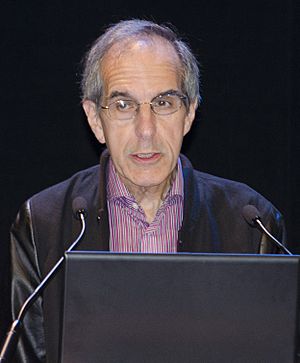Cyrus Chothia facts for kids
Quick facts for kids
Cyrus Chothia
|
|
|---|---|

Cyrus Chothia at the ISMB conference in 2015.
|
|
| Born |
Cyrus Homi Chothia
19 February 1942 |
| Died | 26 November 2019 (aged 77) |
| Education | Alleyn's School |
| Alma mater |
|
| Awards |
|
| Scientific career | |
| Institutions | |
| Thesis | The crystal structures of some molecules active at cholinergic nerve receptors (1973) |
| Doctoral advisor | Peter J. Pauling |
| Other academic advisors | Michael Levitt Frederic M. Richards |
| Doctoral students |
|
| Other notable students | Arthur Lesk (postdoc) |
Cyrus Homi Chothia (born February 19, 1942 – died November 26, 2019) was an English biochemist. A biochemist studies the chemistry of living things. He was a very respected scientist at the Medical Research Council (MRC) Laboratory of Molecular Biology (LMB) in University of Cambridge. He was also an emeritus fellow at Wolfson College, Cambridge. Being an "emeritus" scientist means he had retired but still kept his connection and title with the institution.
Contents
Learning and Early Career
Chothia went to Alleyn's School when he was younger. He then studied at Durham University and earned a Bachelor of Science degree in 1965. Later, he got a Master of Science degree from Birkbeck College in 1967. He then completed his PhD at University College London. A PhD is the highest university degree you can get, showing you are an expert in your field. His supervisor was Peter Pauling, the son of famous scientist Linus Pauling.
After finishing his PhD, Chothia worked at the Laboratory of Molecular Biology (LMB) for three years. He then worked with other important scientists like Michael Levitt at the Weizmann Institute of Science and Joel Janin at the Institut Pasteur in Paris.
Amazing Discoveries in Science
In 1976, Chothia came back to England. He worked at University College London and the LMB again. With another scientist named Arthur Lesk, he found out something important. They showed that tiny changes in a protein's building blocks (called mutations) can make the protein change its shape.
In 1992, Chothia suggested that most proteins are made from a small number of basic building blocks, like how LEGO bricks come in different standard shapes. He worked with other scientists like Alexey Murzin and Steven Brenner to create a special database. This database is called the Structural Classification of Proteins database (SCOP). Think of it like a "periodic table" but for all the known shapes of proteins. It helps scientists understand how proteins are built.
He also worked with Julian Gough to create another database called the Superfamily database. This tool helps scientists find proteins that are related to each other, even if they look a bit different.
During his career, Chothia guided many students who were working on their PhDs. Some of his notable students include Alex Bateman, Steven E. Brenner, Mark Bender Gerstein, Julian Gough, and Sarah Teichmann.
Awards and Special Honours
Cyrus Chothia received many important awards for his scientific work:
Fellow of the Royal Society
In 2000, Chothia was chosen to be a Fellow of the Royal Society (FRS). This is a very high honour for scientists in the United Kingdom. It means he was recognized as one of the best scientists.
His award certificate said that he showed how the tiny parts of proteins decide their shape, what they do, and how they change over time. He also created a way to group protein shapes that is used by scientists everywhere. His work helped us understand how proteins change and gain new jobs. It also explained how a small number of protein shapes can help our bodies fight off many different germs.
ISCB Senior Scientist Award
In 2015, Chothia became a Fellow of the International Society for Computational Biology (ISCB). This society is for scientists who use computers to study biology. He also received the ISCB Accomplishment by a Senior Scientist Award. This award recognized his important work using computers to understand the shapes of proteins.
Dan David Prize
Also in 2015, Chothia was given the prestigious Dan David Prize. He shared this award with David Haussler and Michael Waterman. They received it for their amazing contributions to the field of bioinformatics. Bioinformatics is a science that uses computer tools to understand biological information, like the information in our genes and proteins.

